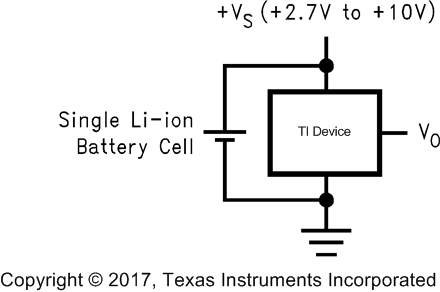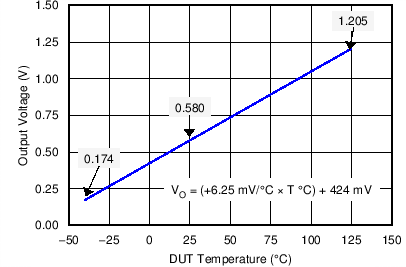JAJS874F May 2004 – August 2017 LM60
PRODUCTION DATA.
- 1 特長
- 2 アプリケーション
- 3 概要
- 4 改訂履歴
- 5 Device Comparison Table
- 6 Pin Configuration and Functions
- 7 Specifications
- 8 Detailed Description
- 9 Application and Implementation
- 10Power Supply Recommendations
- 11Layout
- 12デバイスおよびドキュメントのサポート
- 13メカニカル、パッケージ、および注文情報
パッケージ・オプション
メカニカル・データ(パッケージ|ピン)
サーマルパッド・メカニカル・データ
発注情報
9 Application and Implementation
NOTE
Information in the following applications sections is not part of the TI component specification, and TI does not warrant its accuracy or completeness. TI’s customers are responsible for determining suitability of components for their purposes. Customers should validate and test their design implementation to confirm system functionality.
9.1 Application Information
The device has a low supply current and a wide supply range, therefore it can easily be driven by a battery.
9.1.1 Capacitive Loads
The device handles capacitive loading well. Without any special precautions, the device can drive any capacitive load as shown in Figure 12. Over the specified temperature range the device has a maximum output impedance of 800 Ω. In an extremely noisy environment, adding some filtering to minimize noise pick-up may be required. TI recommends that 0.1 μF be added from +VS to GND to bypass the power supply voltage, as shown in Figure 13. In a noisy environment, adding a capacitor from the output to ground may be required. A 1-μF output capacitor with the 800-Ω output impedance forms a 199-Hz, low-pass filter. Because the thermal time constant of the device is much slower than the 6.3-ms time constant formed by the RC, the overall response time of the device is not be significantly affected. For much larger capacitors, this additional time lag increases the overall response time of the device.
 Figure 12. No Decoupling Required for Capacitive Load
Figure 12. No Decoupling Required for Capacitive Load
 Figure 13. Filter Added for Noisy Environment
Figure 13. Filter Added for Noisy Environment
9.2 Typical Applications
9.2.1 Full-Range Centigrade Temperature Sensor
Because the LM60 is a simple temperature sensor that provides an analog output, design requirements related to the layout are also important. Refer to Layout for details.

Operating From a Single Li-Ion Battery Cell
9.2.1.1 Design Requirements
For this design example, use the design parameters listed in Table 1.
Table 1. Temperature and Typical VO Values of Figure 14
| TEMPERATURE (T) | TYPICAL VO |
|---|---|
| 125°C | 1205 mV |
| 100°C | 1049 mV |
| 25°C | 580 mV |
| 0°C | 424 mV |
| –25°C | 268 mV |
| –40°C | 174 mV |
9.2.1.2 Detailed Design Procedure
Selection of the LM60 is based on the output voltage transfer function being able to meet the needs of the rest of the system.
9.2.1.3 Application Curve
 Figure 15. LM60 Output Transfer Function
Figure 15. LM60 Output Transfer Function
9.2.2 Centigrade Thermostat Application
 Figure 16. Centigrade Thermostat
Figure 16. Centigrade Thermostat
9.2.2.1 Design Requirements
A simple thermostat can be created by using a reference (LM4040) and a comparator (LM7211) as shown in Figure 16.
9.2.2.2 Detailed Design Procedure
Use Equation 2 and Equation 3 to calculate the threshold values for T1 and T2.


9.2.2.3 Application Curve
 Figure 17. Thermostat Output Waveform
Figure 17. Thermostat Output Waveform
9.3 System Examples
9.3.1 Conserving Power Dissipation With Shutdown
The LM60 draws very little power, therefore it can simply be shutdown by driving the LM60 supply pin with the output of a logic gate as shown in Figure 18.
 Figure 18. Conserving Power Dissipation With Shutdown
Figure 18. Conserving Power Dissipation With Shutdown